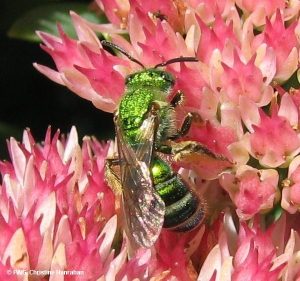by Renate Sander-Regier

Honey Bee (Apis mellifera) on Queen Anne’s lace, a very popular flower with many insects. Notice the big pollen pack on the leg. There was an equally big one on the other leg too. Photo by Christine Hanrahan
Initiatives seeking to protect wild pollinators face many challenges – as well as many rewards.
One of the most common challenges involves helping people distinguish between non-native, domesticated honeybees (a species commercially managed as part of our agri-food system) and native wild bees (many different species that are integral parts of natural ecosystems). When people begin to understand the wide diversity of wild bees – to appreciate their shapes, colours, behaviours, nesting strategies, life cycles, and more – the rewards can be great.
Researchers in Cambridge University’s Department of Zoology published a recent commentary article that sheds valuable light on honeybee-wild bee differences and the problematic dynamics between
- a species that is artificially bred, intensively farmed, commercially managed, widely distributed, and well-known – the honeybee and
- a wide diversity of wild pollinator species, many little-known, misunderstood, and in peril.
While the authors do not question the usefulness of managed honeybees as an agricultural aid, they draw attention to numerous serious issues – many based on misinterpretation and lack of awareness – including:
- the perception that protecting honeybees helps the natural environment and wildlife, with honeybees often presented as symbols of environmental conservation (when, in fact, managed honeybees often threaten wild bees by competing for resources and spreading disease)
- high levels of research on honeybees (e.g., relating to colony collapse and crop protection), but relatively little focus on wild native pollinator declines, including the potential negative role played by domesticated honeybees
- the belief that honeybee decline is a conservation issue, when it is actually an agricultural problem

Native sweat bee in the Agapostemon genus, gathering nectar from sedum flowers. Photo by Christine Hanrahan
In a research summary, one of the authors, Jonas Geldmann, is quoted as saying, “Saving the honeybee does not help wildlife. Western honeybees are a commercially managed species that can actually have negative effects on their immediate environment through the massive numbers in which they are introduced.”
“Keeping honeybees is an extractive activity,” adds the other author, Juan P. González-Varo. “It removes pollen and nectar from the environment, which are natural resources needed by many wild species of bee and other pollinators.”
Geldmann and González-Varo suggest solutions to some of the problems, specifically changing the way honeybees are managed. They recommend, for example, policies that limit the numbers of honeybees active during specific periods, the sizes of honeybee hives, and the transportation of honeybee hives in response to crop flowering times. They also call for controls on beekeeping in protected areas.
Read more
- University of Cambridge. Think of honeybees as ‘livestock,’ not wildlife, argue experts. Science Daily 2018; January 25.
- Charles, D. Honeybees help farmers, but they don’t help the environment. The Salt 2018; January 27.
- Geldmann, J., González-Varo, J.P. Conserving honey bees does not help wildlife (summary) Science 2018; 359(6374): 392-393.